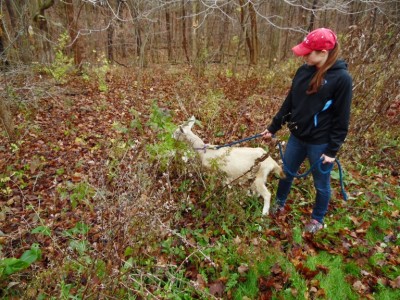No Kidding? Goats!
OWU Student Studies Animals’ Potential to Eat Away at Invasive Plant Problem
Ohio Wesleyan student Meigan Day ’16 is not afraid to think outside the box, especially when considering how to get rid of an invasive honeysuckle plant harmful to the ecosystem.

Mechanical removal of the Amur honeysuckle is difficult, time-consuming, and costly. Inspired by stories of rent-a-goat companies that offer goats for brush removal, Day wondered whether the animals could help control the problematic honeysuckle plant.
“This project reinforces the need to remain creative when it comes to conservation practices,” says Day, an environmental studies and zoology major from Port Clinton, Ohio.
Day conducted research at the nearby Stratford Ecological Center this fall, using its herd of Toggenburg goats. First, she studied whether the goats preferred the taste of honeysuckle over other native plants. Using six types of foliage, she determined the goats favored the flavors of honeysuckle and winged euonymus, more commonly known as burning bush.
“The most challenging part about this project was that I had never worked with goats before,” Day says. “I didn’t know what to expect through my initial feeding tests.”
Next, she tested the goats’ browsing preferences by hanging branches of foliage. The goats circulated and ate all of the available plants. Lastly, Day took a goat into a field with honeysuckle and other shrubs. The goat moved from plant to plant without showing much interest.
In the final analysis, Day concluded that goats, or at least Toggenburg goats tested, are not useful for honeysuckle removal because they do not distinguish between invasive and non-invasive species; however, more research is required.
Though she didn’t hit upon an effective solution this time, Day says it was rewarding to look for a solution and to volunteer to help remove honeysuckle from the Delaware nature preserve. With continued efforts to keep invasive species from re-entering areas, Day believes such work will increase the chance of native species success.
“The work was difficult at times, but when we completed an area it was amazing to observe the different composition of the space once a single invasive species was removed,” she says. “Many environmental issues we face can become easily managed if everyone does their part.”
Day says she was drawn to Ohio Wesleyan by its small class sizes and welcoming atmosphere. After graduation, she will participate in a Travel-Learning Course to Tanzania to learn about the biology of East Africa.
Her career plans include gaining professional experience with data retrieval and analysis to help improve conservation efforts. Ultimately, she hopes to pursue a career in ecology restoration and animal reinstatement.
To read the full account of Day’s research, visit sustainability.owu.edu.
